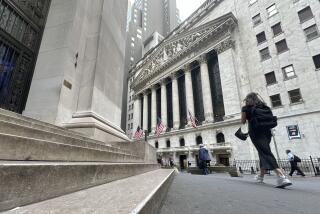Stocks Plunge, Then Recover
The Dow index plunged 440 points Monday before a dramatic reversal left major stock gauges mixed for the session, but investment pros disagreed over whether there were enough signs of a “washout” that could mark a bear market bottom.
Stocks fell almost relentlessly throughout the morning and early afternoon. Heavy trading suggested that many investors who had been on the verge of selling in recent weeks finally pulled the trigger, analysts said.
But with 90 minutes to go in the session and many stocks at new five-year lows, buyers suddenly emerged. The blue-chip Dow industrials closed off 45.34 points, or 0.5%, at 8,639.19. At the low, the Dow had been off more than 5%.
Other major indexes also recovered from deep midday losses. The Standard & Poor’s 500 closed with a loss of 3.46 points, or 0.4%, at 917.93. The Nasdaq composite index posted a net gain of 9.12 points, or 0.7%, to 1,382.62 after being down 58 points.
Despite the wild early plunge and then powerful recovery, analysts said it’s unclear whether selling in the 2-year-old bear market may finally be exhausting itself. At various points since the market peaked in 2000, “panic” selling has appeared to signal a bottom, but it always proved short-lived.
The Nasdaq index has fallen 73% from its all-time high; the S&P; 500 is down nearly 40%.
“We’re probably in the early stages of a capitulation for the general public, but bear market bottoms are tough to pinpoint,” said Bill Ryder, quantitative strategist at Wachovia Securities in Richmond, Va. “They don’t spike down; they grind you lower and lower.”
“There’s a saying that they either scare you out or they wear you out, and this looks like one of those times, like 1973-74, where they just wear you out,” said Kevin Marder, Los Angeles-based strategist at Ladenburg Thalmann Asset Management.
Though key indexes recovered Monday, losers still swamped winners by 23 to 9 on the New York Stock Exchange and by 22 to 13 on Nasdaq. Trading, though heavy, was far from record levels.
Still, some investment pros said Monday’s whiplash had some earmarks of a major turning point.
“It looks like we bounced back pretty dramatically. Maybe this is it,” said Laura Tarbox, a Newport Beach financial planner.
Tarbox has been advising clients not to sell their stock holdings and has suggested that those with cash buy more equities. But when she returned from a two-week vacation Monday, she discovered that five clients had sold out of the market, including two of her biggest accounts.
“Before the last couple of months, we only had a couple of clients capitulate,” Tarbox said.
Historically, at market bottoms, even many die-hard investors find they’re unable to handle the emotional pain of more losses and bail out.
Tarbox believes that “for long-term investors, this is close enough to the bottom,” though she said she is cautious about the market’s next move.
Robert Markman, a Minneapolis financial advisor who acknowledged he “stayed far too long” as a bullish proponent of tech stocks, said Monday’s early selling spree was clearly panic behavior.
Markman Capital Management recommends mutual funds for growth-oriented investors, and those “with a low pain threshold are already out” of the market, Markman said. “Now people with high thresholds are reaching the breaking point.”
“I can’t believe there are people in the industry who still say people aren’t panicking. Give me a break. Investors are saying, ‘Look, I may have lost 40%, 50% or 60% of my money, but being stuck with 40% [of an original investment] is better than watching it go down to 20%.’ ”
Markman still thinks the best bet for stock investors is “to tough it out,” but he’s no longer putting up much resistance if clients want to sell. “If you’re kicking the cat and waking up at 3 in the morning, it’s not worth it,” he said.
At mutual fund giant Vanguard Group in Valley Forge, Pa., spokesman Brian Mattes said he did two-hour stints fielding calls Thursday, which was a big down day for the market, and again Monday. On Thursday, many investors were cutting back on stocks by 10% to 30%, he said.
“That was happening [Monday] too,” Mattes said. “But ... there were a lot of other shareholders going the other way, wanting to get into equities. Every 10 or 15 minutes it seemed like I’d get another buyer moving large amounts in. Some of them were saying they liked the Dow when it was over 10,000, so why not like it now.”
Strategists said they saw no fundamental news to warrant the afternoon reversal. Once it began it may have gotten a boost from “short-covering” by traders who had previously sold borrowed shares, betting on lower prices. Some of those traders may have bought stocks to close their bets.
Early in the day the market ignored what might otherwise have passed for good news. Drug stocks fell despite the planned Pfizer-Pharmacia mega-merger. Traders also were unmoved by President Bush’s latest upbeat speech on the economy, or, initially, by Home Depot’s promise to launch a stock buyback plan, or by mortgage giant Fannie Mae’s better-than-expected earnings report.
Home Depot fell as low as $28, then rebounded to close at $30, up 91 cents. Fannie Mae fell to $70.50, but closed up $2.10 at $72.73.
One potential sign that the market is bottoming is that many battered technology stocks either have rallied over the last week or have fallen less than blue-chip indexes.
Some analysts say it would be a classic end to the bear market if the weakest sectors bottom first, while investors continue to dump their stronger stocks. But strategists say such a pattern is more common in a bull market “correction” than at the end of a prolonged bear market, when timing signals are considered less reliable.
Marder said portfolio managers may have been selling blue chips over the last week in a bid to stabilize their performance by locking in any remaining gains, or, in the case of some mutual funds, to raise cash in preparation for more shareholder redemptions.
The heavy selling of big-name stocks also may indicate that investors anticipate slower economic growth in the second half of the year, and that Congress will approve changes to accounting standards that will sharply crimp reported earnings, some say.
“This goes well beyond the effects of the tech and telecom bubble bursting,” Marder said. “Stocks like the homebuilders, restaurants, defense contractors, apparel retailers and school companies should not being coming apart if everything is OK with the economy.”
Marder pointed to Lockheed Martin in the defense sector, which fell 5.9% on Monday, sliding $3.64 to $58.55. The stock still is up 25% year to date.
Another wild card is that companies may voluntarily make accounting changes that lower their profits, Ryder said, alluding to Coca-Cola’s surprise announcement Sunday that it will begin expensing stock option costs.
“We could have a pretty rough summer, because the competition for companies to come clean adds uncertainty to an already shaky market environment,” Ryder said. “In the long term it’s great because it makes earnings more transparent, but while we go through this process investors may just throw their hands up and say, ‘Forget it.’ ”
*
Market Roundup, C7-8
More to Read
Inside the business of entertainment
The Wide Shot brings you news, analysis and insights on everything from streaming wars to production — and what it all means for the future.
You may occasionally receive promotional content from the Los Angeles Times.











